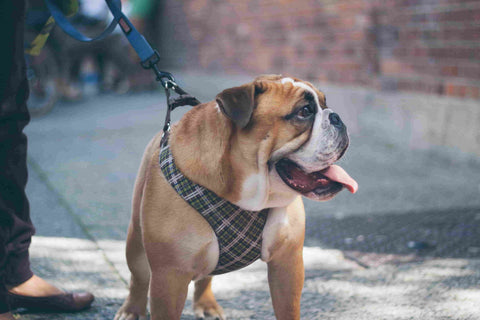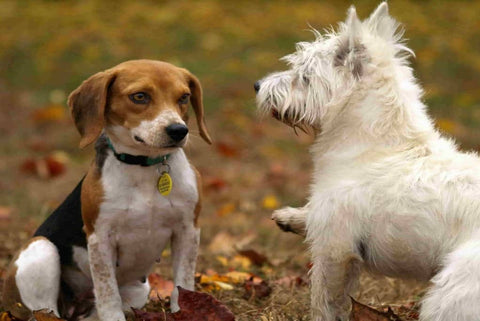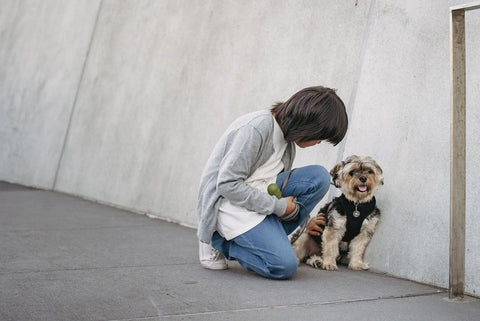How Do No-Pull Dog Harnesses Work? Are They Worth It?
While there’s some hesitancy from many pet owners to try out a no-pull dog harness on their canine pal, rest assured that they are entirely safe and effective when used correctly, especially for dogs who tend to pull.
But just what is a no pull dog harness, and what makes it different from other harness styles? Instead of the traditional placement of the leash clip D-ring on the back of the harness, a no-pull dog harness features the ring at the chest. Other than that, a no-pull harness looks just like any other harness. How no-pull harnesses work is by creating mild discomfort when your dog pulls. The clip location at the front acts as a point of leverage, so if your dog walks ahead of you, the leash will pull him back towards you. He’ll experience a minor loss of balance that will prevent him from pulling forward.
In this article, we’ll discuss how no-pull harnesses work, how to use them, and how to find the best no-pull dog harness.
When Should You Use a No-Pull Dog Harness?
No-pull dog harnesses are an incredible option for any breed that needs to break a pulling habit. At the same time, you’ll be teaching your dog how to walk on a loose leash because he’s learned that tension in the leash means discomfort.
Before you go grab one, though, you need to make sure that you’re picking up the right size harness that fits your dog. Safety and comfort are crucial to making a no-pull harness successful, so double-check that it’s not too loose or too tight. The best no-pull dog harness will have several points of adjustment for a perfect fit.
In general, a no-pull harness serves two primary purposes:
For Discouraging Your Dog’s Pulling
As the name suggests, the main purpose of this type of harness is to discourage pulling and lunging. When your dog pulls while wearing a no-pull harness, there will be some tightening and squeezing at the shoulders. This discomfort signals to him that he needs to hang back a little.
Important: while a no-pull harness will work with any breed of dog, no-pull harnesses work best when they fit well. Take the time to measure your dog correctly to find the perfectly fitting no-pull harness.
For Leash Training
A no-pull harness makes an excellent leash training accessory even if your four-legged friend doesn’t have a pulling problem. Even minor tension in the leash can discourage your dog from walking ahead, so he’ll be loose leash trained in no time!
Important: Dog trainers and experts recommend using a standard harness once your dog can successfully walk with a loose leash on a no-pull harness. This will reduce the risk of the leash tangling up and make daily walks more comfortable for both pet and parent. A dual clip dog harness is a two-in-one accessory that gives you the option of a front or back leash clip, depending on your dog’s current needs.
Benefits of Using a No-Pull Dog Harness
There are several reasons why you might want to give a no-pull dog harness a try. Not only will it deter your dog from pulling on walks and help him learn some loose-leash walking, but it has a ton of other benefits to offer, too. Appropriately sized no-pull dog harnesses work to provide security and comfort for effective training. Here’s what great things you can expect:
No-Pull Training and Leash Training
As we mentioned above, no-pull harnesses are an effective way to stop your dog from pulling, lunging, and running ahead of you. No-pull dog harnesses work much better than a traditional harness for this training. They’re also much safer than walking with a standard collar (which is never recommended; any harness is better than no harness!).
Teamwork
A surprising benefit to walking with a no-pull dog harness is that your dog will become more in tune with your walking pace and the distance they should be at. He’ll soon get a sense of how walking as a pair works, and pretty soon, you won’t need a training harness at all!
Better Safety
The accessory you choose for walking with your dog will have a significant impact on the safety of both of you. A collar is the least recommended because it is easy for a dog that pulls to slip out of it. Plus, pulling with a collar could cause damage to the dog’s neck and throat. A standard back-clip harness is an excellent option if your dog is already trained; it provides comfort and security.
However, for dogs that still have a pulling habit, a no-pull harness is best. The placement of the D-ring means that any pressure caused by pulling is distributed evenly around the chest and shoulder area. The result is discomfort, not pain. This way, your dog learns to avoid that discomfort and stop pulling, all without any risk for injury.
Additional Control
A no-pull harness gives you the best control over your dog’s movements without you having to pull back on the leash. The front-clip location will guide the dog back to you if he puts tension into the leash, virtually pulling himself back in line. That means you have ultimate control without turning your daily walk into a daily workout.
Can a Dog Wear a No-Pull Harness All the Time?
Now that you know how no-pull harnesses work, you might think that they’re an ideal all-the-time accessory. Don’t be fooled: even the best no-pull dog harnesses aren’t designed for all-day wear. Doing so can cause skin irritation and overall discomfort for your pup. Instead, this accessory is more like a special piece of equipment used for an activity. The same way you might wear hiking boots on a camping trip but not lounging around your house, a no-pull harness should be left off when not in use.
And once your dog has the hang of not pulling, you should switch to a traditional harness. To eliminate the need for two separate harnesses, we suggest picking up a dual-clip dog harness that’ll give you the choice of clip location depending on the activity you’re doing together.
Get the Best No-Pull Dog Harness from Pet&Cuddle!
Now you know what a no-pull dog harness is and how it works. And as you’ve just seen, a no-pull dog harness is an unbeatable accessory that belongs in any dog owner’s toolbox, whatever your dog’s breed, size, and age. Combined with a great dog leash, the right no-pull dog harness will give you the best walking and training experience as you work with your dog to get his pulling habit under control.
At Pet&Cuddle, we pride ourselves on our high-quality harnesses, collars, and leashes for every activity. Our experts have designed each one to provide the best comfort, security, and safety possible. Not to mention, with hundreds of styles and designs, they’re pretty stylish, too! All of our carefully created pet accessories have the high quality and durability you’d expect from much more expensive accessories, and that’s because we believe that every dog deserves the best products – even if they pull! So now you can enjoy walking, running, hiking, and more with your dog while you both stay safe and comfortable.
Want to see some of the best no-pull dog training equipment for your canine friend? Have a look at our most recent dog accessory collection and find your no-pull harness today!
Questions about the No-Pull Dog Harnesses
Don’t worry if you still have questions about no-pull harnesses; we’re here to help! Find below some of the most common questions that pet parents like you have.
Are no-pull harnesses good for dogs?
A high-quality no-pull harness is a great accessory for untrained dogs that pull during walks. Compared to traditional harnesses, they’re much more effective for training. Plus, they’re way safer than a regular collar for walking. How no-pull harnesses work is by creating gentle pressure, but it doesn’t hurt the dog at all.
Is it bad for a dog to wear a no-pull harness all day?
Harnesses of all types are designed specifically for walking and other activities, so it’s not a good idea to keep a no-pull harness on your dog all day. Continued use could be uncomfortable or even painful for your pup and could lead to serious health issues.
What is the difference between a no-pull harness and a regular harness?
The difference between these types of harnesses is the placement of the D-ring, where you attach the leash clip. A traditional harness has the D-ring on the back. A no-pull harness has this clip on the front to deter pulling.
What breeds is a no-pull dog harness best for?
Like all harnesses, a no-pull harness is great for any breed! The key is to measure your dog accurately, select the best size, and adjust it appropriately.




